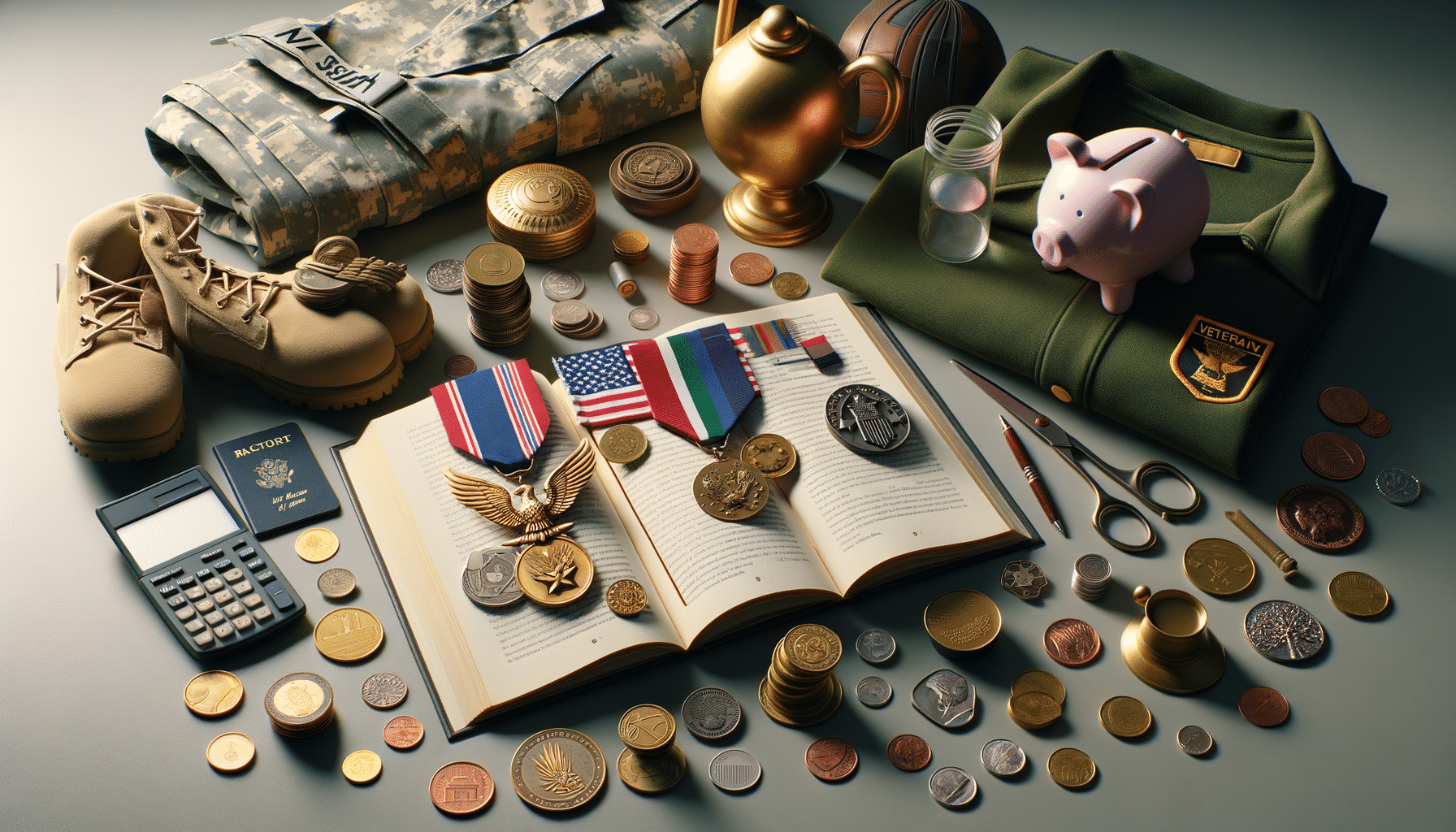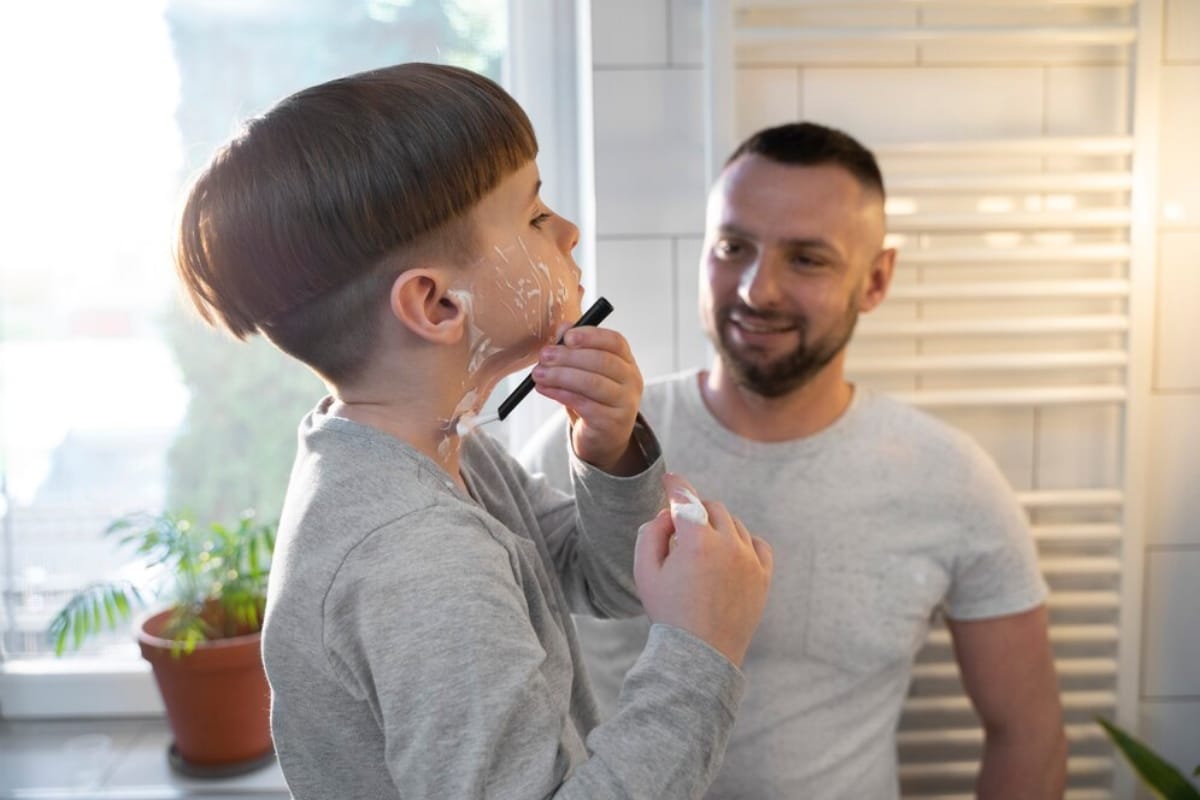
Helping Boys Prepare for Their First Shave
From Peach Fuzz to First Razor
It sneaks up gradually. One day, your son is brushing his teeth with the same carefree energy he had in primary school. Next, he’s squinting in the mirror, tilting his chin, running fingers over a shadow of stubble and asking, “Should I start shaving?”
This seemingly small milestone signals a big leap in independence and self-care. The first shave isn’t just about removing hair — it’s a rite of passage. It marks a moment where a boy starts to see himself differently and consider how he presents himself to the world.
For parents, it’s a chance to guide your child with empathy and expertise. Whether your son is nervous, excited, or completely indifferent, your support can make this milestone feel manageable, safe, and even empowering.
In this blog post, we’ll explore how to help boys prepare for their first shave. We’ll cover when shaving typically starts, how to choose the right tools, teach safe technique, and have honest conversations that build confidence, not pressure.
Understanding First Shaving and Puberty
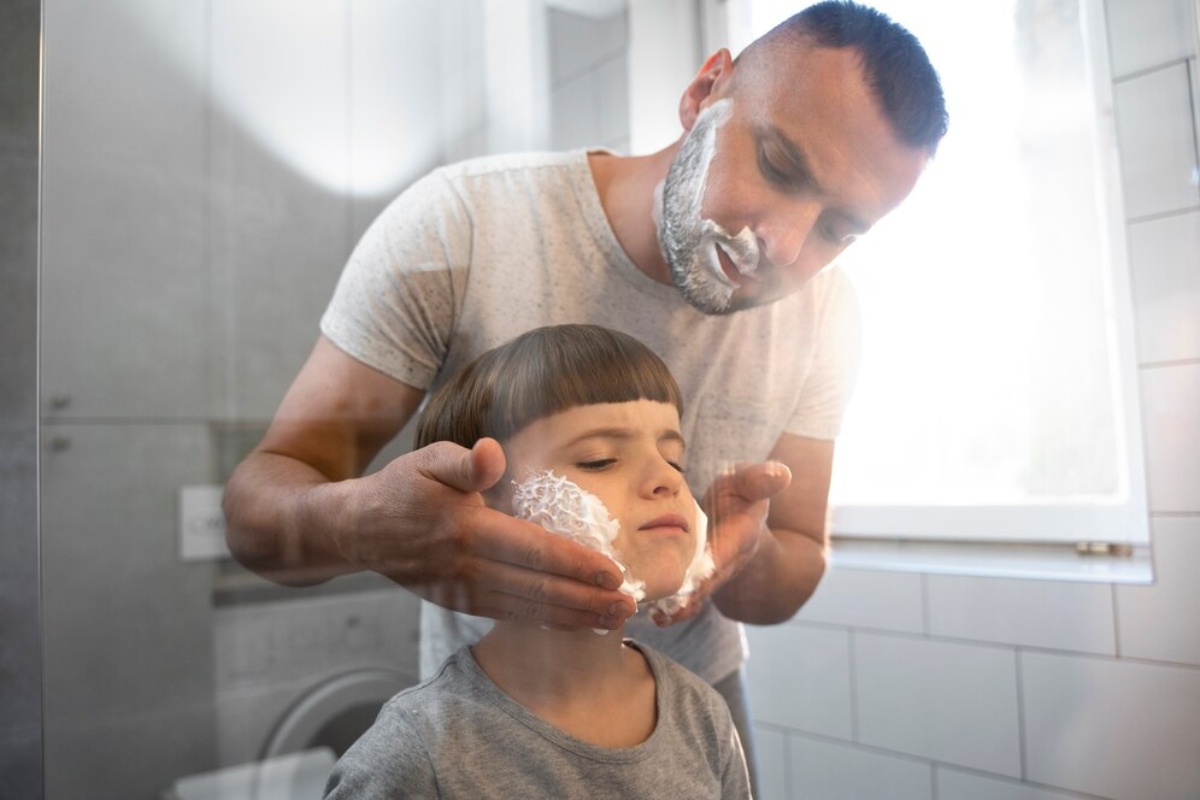
When Do Boys Typically Start Shaving?
Boys usually begin to notice facial hair between the ages of 11 and 15, depending on when puberty begins. According to the NHS, facial hair growth follows a predictable pattern:
- Soft “peach fuzz” above the upper lip
- Downy hair on the sideburns and chin
- Gradual thickening into coarser stubble
Shaving may not be necessary right away. The decision often depends more on how a boy feels about the hair than on how visible or thick it is. For some, the goal is a cleaner look. For others, it’s about fitting in or trying something new.
Why the First Shave Matters
The first shave is about more than grooming. It’s about:
- Learning a life skill with guidance
- Exploring identity and self-image
- Boosting confidence through self-care
- Marking a stage of personal growth and maturity
Handled well, it becomes a bonding experience. Handled poorly, it can cause cuts, embarrassment, or confusion.
Starting the Conversation: Timing and Tone
How to Know It’s Time
Look for signs like:
- Comments about facial hair or appearance
- Questions about razors, grooming, or skincare
- Peer influence (e.g. “My friend has started shaving”)
- A visible darkening or thickening of hair above the lip or jaw
Don’t rush — but also don’t wait until they’re frustrated or insecure. A proactive conversation gives them permission to ask, learn, and feel ready.
Starting the Chat
Choose a relaxed moment — no big speeches or lectures.
Keep it casual and open-ended:
- “You’ve probably noticed some changes with your face lately. Have you thought about shaving?”
- “Want to learn how to shave properly before trying it yourself?”
- “When I was your age, I cut myself a lot until someone showed me the ropes. Want to skip that part?”
If your son is shy, try leaving a grooming kit in the bathroom with a note offering help — it’s often easier to say yes to a gentle offer than to start the conversation.
What You’ll Need: A Beginner-Friendly Shaving Kit
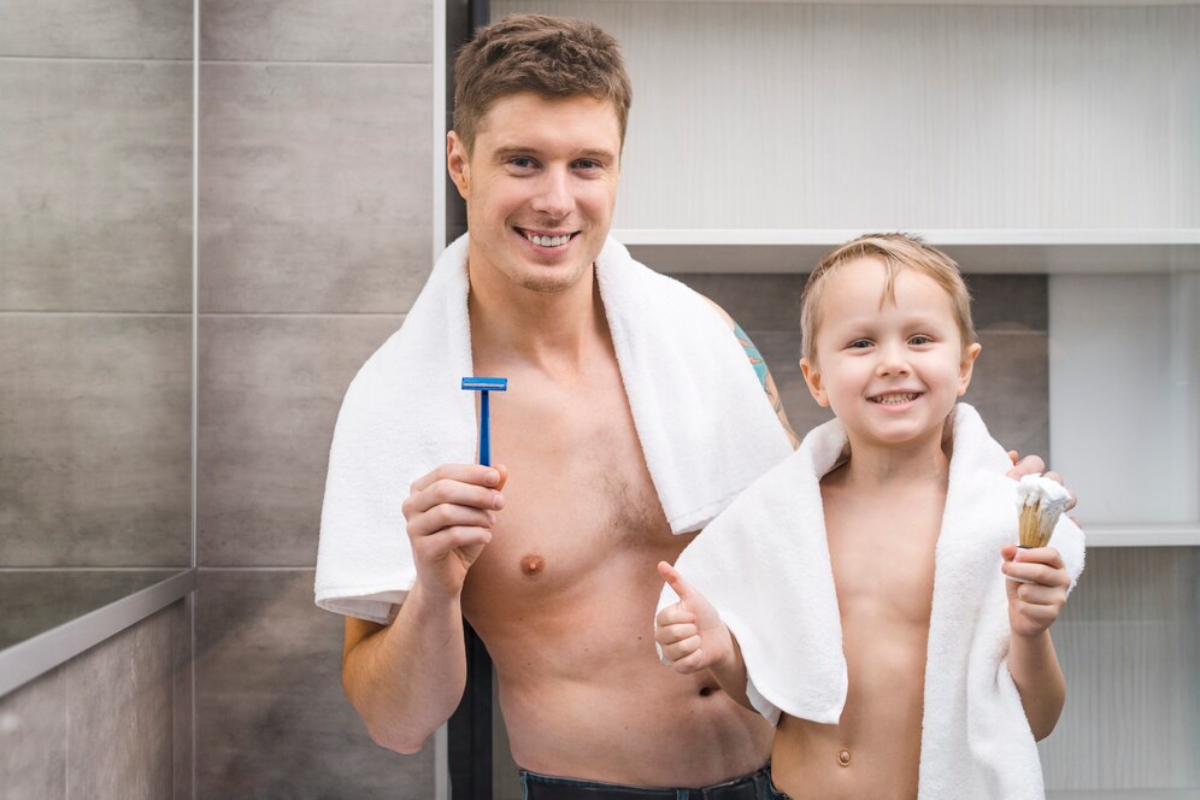
Start with simple, safe, and age-appropriate tools. You don’t need to spend a fortune, but quality matters.
Essentials for a First Shave Kit:
- Electric shaver or manual safety razor (with a protective blade)
- Electric razors are great for beginners. They’re safer, faster, and less intimidating.
- Shaving gel or cream
- Choose a fragrance-free or sensitive-skin formula.
- Aftershave balm or moisturiser
- Avoid alcohol-based products that sting or dry the skin.
- Face cloth and mirror
- A clear mirror and warm water are key to safe prep.
Optional extras:
- A small towel or shaving bib to catch hair
- An introductory grooming book or printout
Teaching the First Shave: A Step-by-Step Guide
1. Prep the Face
Start by washing the face with warm water and a mild cleanser. This:
- Removes oil and dirt
- Softens the hair
- Opens up pores for a smoother shave
Encourage shaving after a warm shower for best results.
2. Apply Shaving Cream
Demonstrate how to:
- Squeeze a small amount into the palm
- Rub it between your hands or use a brush
- Apply an even layer over the shaving area (usually the upper lip and chin)
Creams reduce friction and protect against cuts.
3. Shave Gently and Slowly
Key rules:
- Always shave in the direction of hair growth
- Use short, light strokes — no need to press hard
- Rinse the blade every few strokes to remove buildup
Talk about avoiding pressure. Many first-time shavers mistakenly push the blade into their skin, causing nicks and irritation.
4. Rinse and Soothe
Once finished, rinse the face with cool water to close the pores. Gently pat dry with a towel — no rubbing.
Apply a soothing balm or moisturiser to calm the skin and prevent dryness.
5. Clean Up
Show how to:
- Rinse and dry the razor
- Dispose of used blades safely (if applicable)
- Wipe the sink clean
This teaches responsibility and respect for shared spaces.
Tips for Shaving Confidence
- Don’t expect perfection the first few times. Even adults miss spots.
- Avoid daily shaving at first — shaving every few days is enough for light or patchy growth.
- Normalise mistakes — a small cut or uneven shave isn’t a failure.
- Celebrate the milestone if your child wants to. A “first shave” moment can be quietly special, like a step into growing up.
Managing Skin Concerns During Puberty
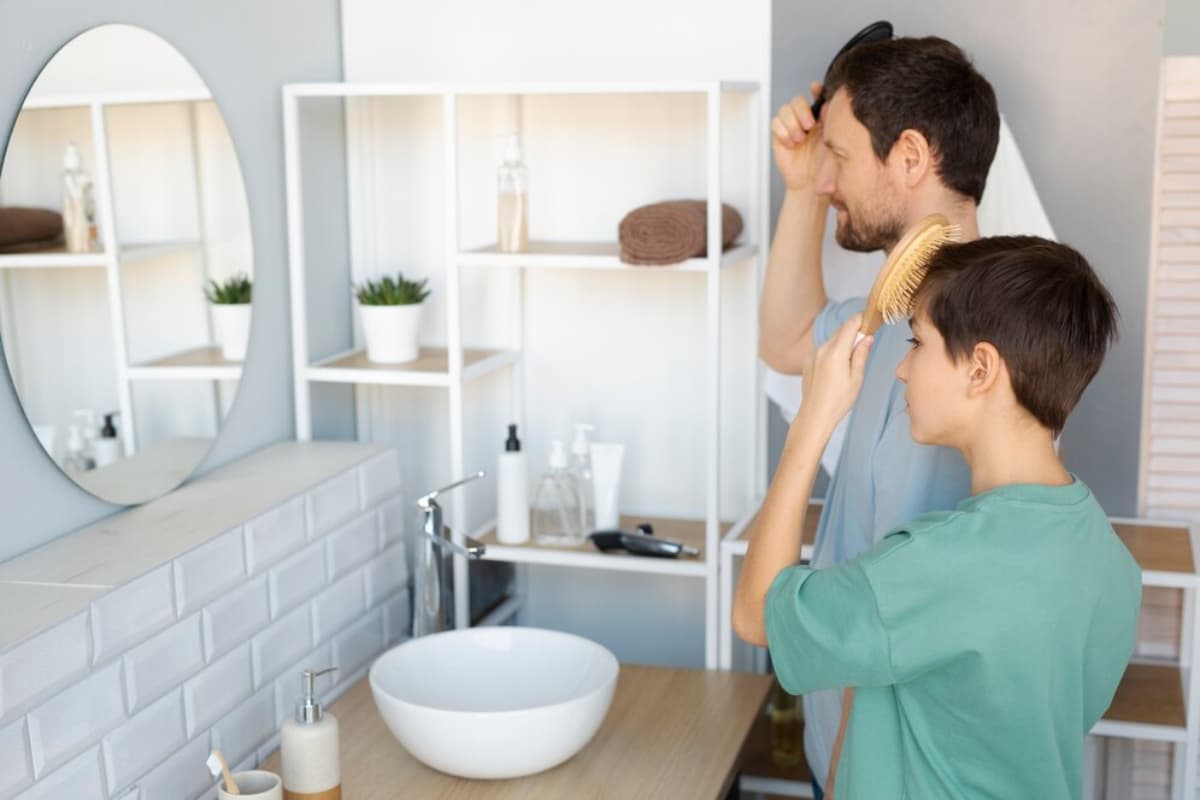
Shaving can irritate sensitive or acne-prone skin.
Let your child know:
- Shaving won’t cause acne, but poor technique can worsen breakouts
- Use non-comedogenic products that don’t clog pores
- If the skin is inflamed, wait a few days before shaving again
- For stubborn spots, visit a GP or dermatologist for advice
Encourage them to gently exfoliate 1–2 times a week with a mild scrub or cloth to prevent ingrown hairs.
Addressing Puberty Grooming Questions
Your son might ask about:
- When to shave underarms or body hair: Let them know there’s no rule. It’s personal and cultural.
- Using cologne or aftershave: Start with gentle, skin-friendly products, and remind them that less is more.
- Eyebrows, chest hair or grooming trends: Be open, non-judgemental, and guide them toward safe, age-appropriate choices.
Help them understand that personal grooming is about feeling good, not conforming to peer pressure or social media trends.
What About Boys Who Don’t Want to Shave?
Some boys are happy to let facial hair grow, especially if they want a moustache or are proud of early development.
That’s okay too.
Let them know:
- There’s no rush or rule — shaving is a choice
- You’re available if they ever want help
- Hygiene and confidence are more important than style conformity
Respecting their decision builds trust and ensures they’ll come to you when they’re ready.
When to Seek Help or Extra Support
If your child shows signs of distress about grooming or their changing body, it may be worth checking in more deeply.
Look out for:
- Obsessive grooming habits
- Avoiding mirrors or school
- Feeling “ugly” or ashamed of facial hair
- Constant comparison with influencers or peers
In these cases, start with open-ended questions, and if needed, speak with a school counsellor or GP.
Conclusion: A Smooth Start to a Lifelong Skill
Helping your son through his first shave is about more than blades and cream — it’s about building comfort, trust, and independence. It’s about turning what could be an awkward or stressful moment into one of support and connection.
By offering knowledge without pressure, tools without judgment, and time without expectation, you’re helping your child step into this new phase of life with confidence.
So why not start today? Have the conversation. Set up a beginner kit. Offer to demonstrate, or simply watch and cheer them on. Your presence is the most valuable part of the process.
Have you helped your child with their first shave? What worked — or didn’t? Share your story or shaving tips in the comments. Your experience could be the guidance another parent needs.


